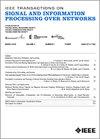The Coherence and Robustness Analysis for a Family of Unbalanced Networks
IF 3
3区 计算机科学
Q2 ENGINEERING, ELECTRICAL & ELECTRONIC
IEEE Transactions on Signal and Information Processing over Networks
Pub Date : 2025-04-09
DOI:10.1109/TSIPN.2025.3555164
引用次数: 0
Abstract
This study focuses on the coherence in a class of unbalanced networks, emphasizing the investigation of the impact of leader selection and network parameters on coherence. We discuss three different categories of consensus algorithms: leaderless algorithms of first and second orders, and first-order leader-follower algorithm. Firstly, we derive exact solutions for leaderless network coherence in the first and second orders. Secondly, we design various leader allocation schemes for the first-order leader-follower networks, obtaining expressions correlated with the network scale一类不平衡网络的相干性和鲁棒性分析
本研究以一类非平衡网络为研究对象,着重探讨了领导者选择和网络参数对连贯性的影响。讨论了三种不同类型的共识算法:一阶和二阶无领导算法和一阶领导-追随者算法。首先,我们推导了无领导网络一阶和二阶相干性的精确解。其次,针对一阶leader-follower网络设计了各种leader分配方案,得到了网络规模N$、双环基数p$和q$以及leader数量k$的相关表达式。第三,我们通过数值模拟和鲁棒性分析来探讨领导者数量和拓扑结构对网络一致性的影响。具体而言,结论如下:(1)当$N$减少时,$k$增加表明网络连贯性提高。(2) $p$与$q$的差异越小,相干性越好。(3) $p$与$q$的和越小,鲁棒性越强。(4) $k_{1}$和$k_{2}$的均匀分布使相干性达到最佳。最后,分析了网络的拉普拉斯能量和基尔霍夫指数。
本文章由计算机程序翻译,如有差异,请以英文原文为准。
求助全文
约1分钟内获得全文
求助全文
来源期刊

IEEE Transactions on Signal and Information Processing over Networks
Computer Science-Computer Networks and Communications
CiteScore
5.80
自引率
12.50%
发文量
56
期刊介绍:
The IEEE Transactions on Signal and Information Processing over Networks publishes high-quality papers that extend the classical notions of processing of signals defined over vector spaces (e.g. time and space) to processing of signals and information (data) defined over networks, potentially dynamically varying. In signal processing over networks, the topology of the network may define structural relationships in the data, or may constrain processing of the data. Topics include distributed algorithms for filtering, detection, estimation, adaptation and learning, model selection, data fusion, and diffusion or evolution of information over such networks, and applications of distributed signal processing.
 求助内容:
求助内容: 应助结果提醒方式:
应助结果提醒方式:


